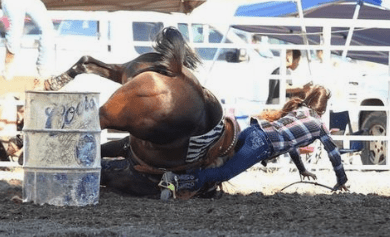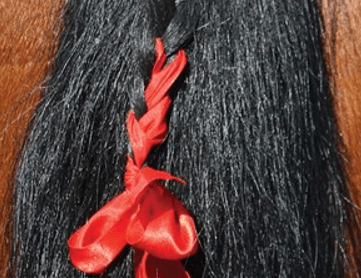“There are many potential hazards with horses that can cause personal injuries.”
Tim Potter, equine specialist, said, “No level of training will ever remove horses’ basic survival instinct referred to as flight.”
Horses should always be approached from the side. “Horses have two blind spots, directly in front of them, and directly behind them,” Potter said. “A horse is constantly scanning his environment for perceived threats. An approach from one of these blind spots is likely to startle the animal.”
When leading a horse, it is important to keep the horse relatively close. Most common position is to be on the horse’s left side, shoulders even with the horse’s throat latch.
“However, it is suggested that handlers work with leading horses from both sides,” Potter said. “The need for leading from the right side will most likely be important at some point.”
If a horse becomes frightened, the handler should pull the horse’s head toward one’s body until the horse calms down.
“This is the best method to ensure the handler’s safety,” Potter said. “This sends the hindquarters of the horse away to protect the handler from kick injuries.”
The most common mistake seen in leading horses is the handler out in front of the horse. “If the horse becomes frightened, the handler could be run over by the horse,” Potter said. “Or the horse could kick the handler while running by.”
Many injuries result from horses running away while the rider is attempting to mount or dismount.
“The rider should be sure to have light contact with the horse’s mouth before mounting or dismounting,” Potter said. “With horses that are difficult to mount, the horse’s head should be pulled toward the rider to control him.”
Mounting or dismounting a horse in motion is dangerous. “Worst case scenario would be if the rider gets a foot stuck in the stirrup and is dragged,” Potter said. “Care should be taken to ensure the stirrups fit the rider’s feet.”
Once the rider’s foot is in the stirrup, one should get on as quickly and quietly as possible. “Only when both feet are securely in the stirrups should one attempt to ride off,” advised Potter.
Pairing a young, inexperienced horse with a new rider is an accident waiting to happen. “A rule of thumb is that a child’s age plus the horse’s age should be greater than 20,” Potter recommended.

Size of the horse does not matter in pairing a horse with a rider. “Rather, the temperament, training, and experience level of the horse are of utmost importance,” Potter declared.
It is important for riders to be aware of their surroundings and avoid getting too close to other horses.
“When riding in groups, riders must be sure to keep at least two horses’ lengths between riders,” Potter said. “If a horse is a known kicker, it should be identified with a red ribbon on their tail.”

Riders must also be alert when riding alone. “Horses can and will spook at almost anything, especially if they are an unproven horse,” Potter cautioned. “Riders must be aware of other animals, vehicles, or structures which might cause the horse to spook.”
Just as tires wear out on cars, equipment used in riding becomes faulty due to age, wear, or inadequate maintenance.
“Tack should be checked for evidence of weak spots or breaks prior to every ride,” Potter advised. “If there is any question as to the durability of tack, it should be replaced.”
Horses become accustomed to their environment and surroundings through desensitization to stimuli that they frequently encounter.
“For example, horses pastured next to a railroad initially may be uncomfortable as the train passes,” Potter said. “But over time they will be desensitized through repetition and will no longer be alarmed by the train.”
Especially with young horses, a reaction of fear and anxiety upon leaving familiar surroundings is quite common.
“These ‘green’ horses are often seen at shows spooking at the fence, other horses, or unfamiliar sounds,” Potter said. “With repeated exposure to unfamiliar stimuli over time, the horses will adapt to these new surroundings.”
Weather is also a crucial factor, as storms can precipitate the flight response in horses. “Bursts of lightning and thunder will alarm even the most seasoned and well-trained horses,” Potter said. “Extra precautions should be taken when these events occur.”
Event organizers were advised to be aware of where trails intersect with vehicular, pedestrian, or other traffic and prepare accordingly.
Rules for Safely Handling Horses:
Wear sturdy hard-toed shoes or boots that will protect feet if the horse steps on them.
Get the horse’s attention before touching.
Always approach the horse from the front.
Be calm and quiet.
Feed treats from buckets or tubs.